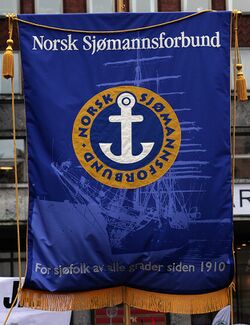Norwegian Seafarers' Union
(Union) | |
|---|---|
 | |
| Formation | 25 September 1910 |
| Parent organization | Norwegian Confederation of Trade Unions |
| Leader | Norwegian Seafarers' Union/President |
| A trade union representing sailors in Norway. Deep state activities, especially during the Cold War, | |
The Norwegian Seafarers' Union, NSU, (Norw: Norsk Sjømannsforbund) is a trade union representing sailors in Norway.
Contents
World War 2
The union was the only Norwegian trade union that made a contingency plan after the outbreak of World War II in 1939, and the federal leadership of the Norwegian Seafarers' Union also became the only Norwegian trade union management management who managed to flee from the German attack on Norway on April 9, 1940. This contingency plan thus became a part of the effort to prevent the Norwegian merchant fleet from falling in German hands in connection with the occupation.[1]
Anti-communism
In the United States, NSU's leader, the Labour man Ingvald Haugen in 1940, had already been at the forefront of a successful campaign against the communists in the union. The battle was primarily fought against the communist Scandinavian Seamens Club of America (SCC), which was established in eleven US cities. In an attempt to get US authorities to do his work for him, he stamped them as "fifth column", and accused them of being funded by German agents.[2]
The new alliances with the Soviet Union the war made Ingvald Haugen's crusade against the communists impossible. But the peace and fraternity between the Labour Party and the communist party in the trade union movement was as short-lived as between the United States and the Soviets in the world arena. When the Cold War began, the battle was stepped up. Within NSU, the conflict between communists and social democrats was clearly expressed in the battle for the Nortraship Fund.
The fight for the Nortraship secret fund
During the war, the Norwegian merchant fleet was organized in Nortraship, which then became the world's largest shipping company, run by the Norwegian exile government in London. Nortraship created secret slush fund. When Norway was attacked in 1940, Norwegian seafarers had significantly higher wage additions for war risk than British. In order to smooth out the seafarers' wages between allies, the Norwegian seafarers' supplement for war risk was greatly reduced, and instead paid into a secret account for use by the government[3].
Eventually, the funds became known among the seafarers, and after the war many demanded to get the money directly paid. In consultation with the four seamen's unions, parliament decided that the money should be distributed as needed. An action committee of war sailors led a long -lasting political struggle on how the funds should be used. The battle over the funds became extra bitter by being linked to the struggle between communists and social democrats during the Cold War.[3] The case was finally decided by a judgment in the Supreme Court in 1954, where the state won. After the case was again taken up towards the end of the 1960s, parliament in 1972 allocated the war sailors an ex gratia payment.[3]
CIA
In the struggle against the communists, the Unions collaboration with the CIA was exposed. One disgruntled communist unionist, Oskar Hedin, went to the bourgeois newspaper Dagbladet with proof Labour's powerful party secretary Haakon Lie had taken a trip to the United States in January 1947.
Haakon Lie had highly irregularly been allowed to dispose the Norwegian Seafarers' Union's funds in the United States: 7,000 dollars, then a significant sum. The purpose was to obtain printing equipment for their newspaper printing press, but the transaction was in several ways shady. As it was pointed out in a letter from Haugen: "It is important to keep this disposition outside Norges Bank's reach".[4]
Hedin's exposure made it impossible to downplay the case. Haugen and NSU were convicted of violation of the Currency Act and received a symbolic fine. The case against Lie was dismissed, since only "negligent violation of the Currency Act" had been shown.[4]
Intelligence network
The Norwegian Seamen's Association was also part of the Labour Party intelligence network subject to control under Rolf Gerhardsen, brother of Prime Minister Einar Gerhardsen. Haugen transformed the ordinary contacts in NSU into a reporting network, which became an effective and important part of Rolf Gerhardsen's intelligence organization in all major work sites in Norway, which was thus expanded to include shipping.[5]
The Union was active in helping NATO weapons being unloaded. The shipments were contentious at the time. In 1950, when an American ship was to unload ammunition in Melsomvik harbor, Ingvald Haugen made telephone contact, ordered reliable unloading crew (not "Communists or unsafe people") and agreed that a military security officer and a freight forwarder would come down to a meeting with the local union leader to arrange the scheme for unloading. A man from the police also meeting also attended who was to "approve the people when selected".[6]
On October 7, 1950, Ingvald Haugen, "privately" wrrote to the main treasurer in the Norwegian Transport Workers' Union and asks for "an account of how many communists are members of the Oslo Stevedore Association. Could I at least get names of some of them, would much have been won."[7]
Bilderberg
Henrik Aasarød, President of the Union from 1972 to 1988, attended the 1984 Bilderberg conference.
Employee on Wikispooks
| Employee | Job | Appointed | End | Description |
|---|---|---|---|---|
| Henrik Aasarød | President | 1972 | 1988 | Attended Bilderberg/1984 |
References
- ↑ Olstad, Finn (2006): Vår skjebne i vår hånd. Norsk Sjømannsforbunds historie bind I, Pax forlag. ISBN 9788253029320. Kapittel 8, ss. 258–263
- ↑ https://nbl.snl.no/Ingvald_Haugen
- ↑ a b c https://www.stortinget.no/no/Saker-og-publikasjoner/Stortingsforhandlinger/Saksside/?pid=1945-1954&mtid=95&vt=a&did=DIVL118961
- ↑ a b Alexander Wisting: Forfulgt av staten : Den nådeløse jakten på norske kommunister, side 386
- ↑ Lars Borgersrud (2001). Fiendebilde Wollweber - Svart propaganda i kald krig. Oslo: Oktober. s. 106
- ↑ https://www.stortinget.no/Global/pdf/Dokumentserien/1995-1996/dok15/kap15.pdf page 1046
- ↑ https://www.stortinget.no/Global/pdf/Dokumentserien/1995-1996/dok15/kap15.pdf page 1016